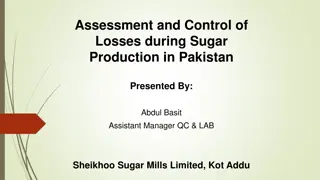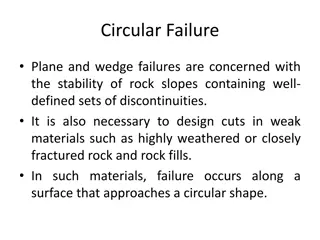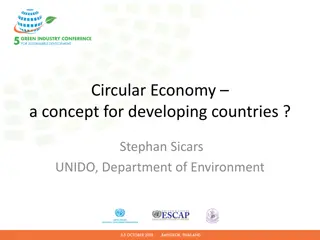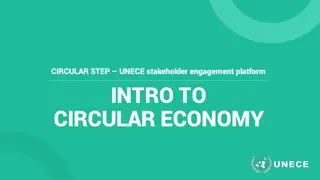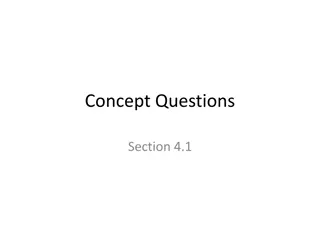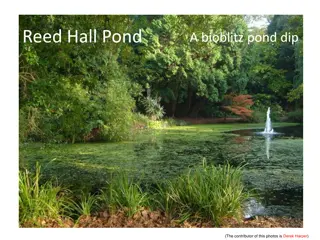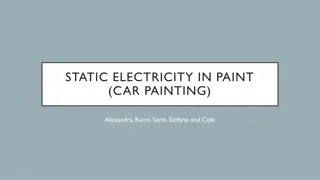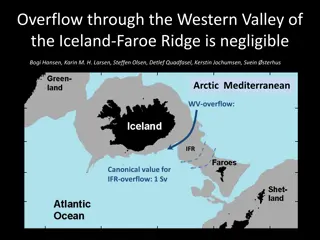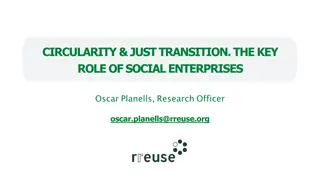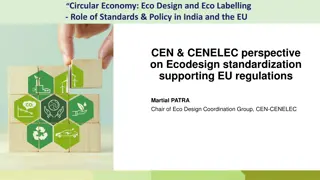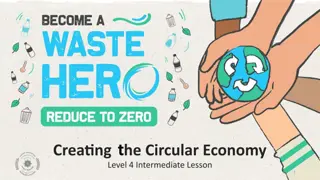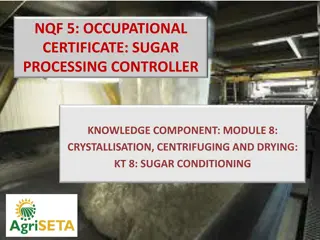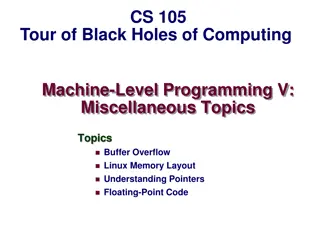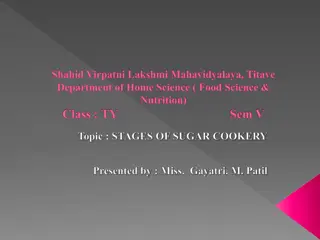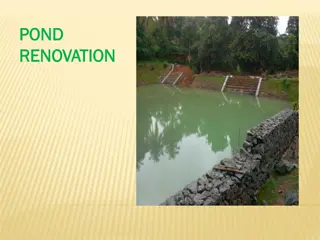Role of Sugar Industry in Circular Economy - Case Study on Spray Pond Overflow Treatment
The two-day summit organized by Mahatma Phule Krushi Vidhyapeet Krushi Mahavidhyalaya, Pune, in collaboration with various organizations, focused on the significant role of sugar and allied industries in promoting circular economy and sustainability. The event highlighted the necessity of treating spray pond overflow from sugar mills to mitigate water pollution. M/s. Krantiagrani Dr. G.D. Bapu Lad Sahakari Sakhar Karkhana Ltd., a cooperative sugar mill, shared insights on their approach to treating spray pond overflow using advanced biological processes. The impact of discharging untreated effluents was also discussed, emphasizing the importance of environmental sustainability in the sugar industry.
Download Presentation

Please find below an Image/Link to download the presentation.
The content on the website is provided AS IS for your information and personal use only. It may not be sold, licensed, or shared on other websites without obtaining consent from the author. Download presentation by click this link. If you encounter any issues during the download, it is possible that the publisher has removed the file from their server.
E N D
Presentation Transcript
MAHATMA PHULE KRUSHI VIDHYAPEET KRUSHI MAHAVIDHYALAYA, PUNE MITCON CONSULTANCY & ENGINEERING SERVICES LTD., PUNE SUGAR COMMISSIONER OFFICE, PUNE & THE ENVIRONMENT ASSOCIATION OF MAHARASHTRA JOINTLY ORGANIZED TWO DAYS SUMMIT ON ROLE OF SUGAR AND ALLIED INDUSTRIES IN CIRCULAR ECONOMY & SUSTAINABILITY VENUE : DR. SHIRNAME HALL, AGRICULTURE COLLEGE, PUNE TOPIC:CASE STUDY ON SPRAY POND OVERFLOW TREATMENT PLANT MR. SAGAR B. PATIL : MANAGER ENVIRONMENT M/S KRANTIAGRANI DR. G. D. BAPU LAD S.S.K. LTD., KUNDAL, TAL. PALUS, DIST. SANGLI
INTRODUCTION In the sugar industry, a spray pond is an essential unit for cooling the hot water generated during the sugar extraction process. By dispersing this hot water over a large surface area through sprays, the pond facilitates heat loss via evaporation and convection. However, the overflow from the spray pond is a major source of water pollution from a sugar mill. According to the guidelines of the Ministry of Environment, Forest, and Climate Change (MoEF&CC) and the Central Pollution Control Board (CPCB), it is mandatory to treat the spray pond overflow before discharge. The charter outlines four options for treating spray pond overflow, and the sugar mill has installed a separate treatment plant of capacity 850 cum/day for the spray pond overflow treatment involving two stages of biological treatment: anaerobic and aerobic processes followed by tertiary treatment.
INTRODUCTION OF THE SUGAR MILL M/s. Krantiagrani Dr. G.D. Bapu Lad Sahakari Sakhar Karkhana Ltd. is a cooperative sugar mill located in Village Kundal, Taluka Palus, District Sangli, Maharashtra. The mill was established under the dynamic leadership of the late freedom fighter Krantiagrani Dr. G.D. Bapu Lad. It is currently guided by the visionary leadership of former Chairman and MLA Mr. Arun Ganapati Lad and Chairman Mr. Sharad Lad. Sugar Factory Crushing Capacity : Sugar unit : 8500 TCD Co-generation unit : 19.70 MW Distillery unit : 260 KLPD Spray Pond OverflowEffluent quantity : Sugar mill effluent refers to the wastewater generated during the sugar production process. This effluent typically contains high levels of organic matter, including sugars, suspended solids, and various pollutants. On the major source of effluent generation is spray pond overflow the quantity of this effluent is equal to the other effluent sources which is nearly 100 Lit/tone of cane crush and which is mandatory to treat before discharge
AVERAGE INLET & OUTLET QUALITY & QUANTITY OF THE SPRAY POND OVERFLOW # Characteristics. Inlet Value Outlet Value Discharge Norms 1 pH 4.5 - 6.5 5.5-9.5 5.5-9.5 2 Suspended Solids, mg/L 400-600 <100 100 3 Total Dissolved Solis, Max., mg/L 1500-2000 <2100 2100 BOD, 5 days at 20 o C, mg/L 4 500-700 <30 30 5 COD, mg/L, Max. 1000-1500 <250 250 6 Sulphate 1000-1200 <1000 1000
IMPACT OF DISCHARGING SPRAY POND OVERFLOW EFFLUENT WITHOUT TREATMENT The overflow discharge from sugar industry spray ponds can have significant environmental impacts if not properly treated. Here s a breakdown of some potential effects on land: Soil Contamination: Sugar industry effluents often contain high levels of organic and inorganic compounds when these substances overflow and come into contact with soil, they can alter its chemical composition, potentially leading to contamination with heavy metals and other pollutants. Nutrient Imbalance: The discharge might introduce excess nutrients, such as nitrogen and phosphorus, into the soil. This can disrupt the natural nutrient balance, leading to issues like soil degradation and reduced fertility. Soil pH Changes: The acidic or alkaline nature of the effluent can alter the soil pH. This shift can affect the availability of nutrients and the health of plants. Groundwater Contamination: If the overflow seeps into the groundwater, it can lead to contamination of water resources. This can pose risks to drinking water quality and affect ecosystems dependent on groundwater. Health Risks: Persistent exposure to contaminated soil or water can pose health risks to humans, including potential issues related to waterborne diseases or chemical exposure. Odor and Aesthetic Issues: The overflow can produce unpleasant odors and create unsightly conditions. This can affect local communities and reduce the quality of life for nearby residents.
DESIGN PARAMETERS CONSIDERED FOR DESIGNING OF TREATMENT PLANT # Parameter Concentration 800-850 m3/day 1 Quantity 2 pH 6.5 -8.5 3 Temperature 40 - 50 0C 4 BOD 2000 mg/l 5 COD 4000 mg/l 6 TDS 600 1800 mg/l 7 Sulphate 1000-1200 Mg/l
PHOTOGRAPHS OF THE PLANT Equalization Tank Anaerobic Filter Tank Aeration Tank Filter feed tank Tertiary Filters Secondary Clarifier
Treated Water Collection Tank Treated Water Treated Water
ELECTRICITY, CHEMICAL AND MAN POWER REQUIREMENT DURING OPERATION POWER CONSUMPTION Units Power Consumption in HP Power Consumption in KW/hr CHEMICAL CONSUMPTION Feed Pumps: 2 No s 7 5.21 (1 w + 1 S) Urea/Day DAP/Day Sludge Withdrawal Pumps: 4 2.98 4.0 KG 2.0 KG 4 No s (2 w + 2 S) DAILY MANPOWER CONSUMPTION Air Blower: 2 No s 25 18.64 (1 w + 1 S) Chemist/Day Operator/Day Clarifier Mechanism 1 Nos 1 0.74 1 No 3 Nos Filter Feed Pump 10 7.45 Total 47 HP 35.02 KW/Hr
OPERATIONAL COST ESTIMATION Electricity consumption Man power requirement Electrify consumption per Hr: 35.02 KW 1 Chemist : Rs. 500 /- per Day Daily electricity consumption : 35.02 x 24 hr : 840.84 Kw 3 no's operator : Rs. 1200 per Day (400/Person) Rate of electricity per Kw: Rs. 4.25 /- Total Cost: Rs. 1700 /- Per Day Total cost per day : 840.84 x 4.25 : Rs. 3,572.04 /- Man power requirement 1 Chemist : Rs. 500 /- per Day Chemical consumption (Urea & DAP) 3 no's operator : Rs. 1200 per Day (400/Person) Urea consumption per day: 4.00 Kg Total Cost: Rs. 1700 /- Per Day Cost of urea per Kg : Rs. 5.4 /- Daily cost of Urea : 4.00 Kg X Rs. 5.4 : Rs. 21.60 /- Total Daily Operational Cost DAP consumption per day: 2.00 Kg Particulars Cost in Rs. Cost of urea per Kg : Rs. 30.00 /- Electricity consumption 3,572.04 /- Chemical consumption 81.60 /- Daily cost of Urea : 2.00 Kg X Rs. 30 : Rs. 60.00 /- Manpower 1700.00/- Total cost of Urea & DAP : Rs. 21.60 + 60.00 : Rs. 81.60 /- Total Cost/Day 5353.64/-
COD ANALYSIS IN THE SEASON 2024 FEB 2024 MARCH 2024 JAN 2024 400 500 800 450 435 344 685 450 350 700 400 591 300 600 Average COD (Mg/Lit) Average COD (Mg/Lit) Average COD (Mg/Lit) 350 251 250 500 300 200 250 400 320 190 200 150 300 150 100 200 90 136 100 46 31 50 100 50 0 0 0 Collection Tank Anaerobic Tank Secondary Clarifier Treated water Collection Tank Anaerobic Tank Secondary Clarifier Treated water Collection Anaerobic Clarifier Treated Up to 90 % COD Reduction observed Up to 80 % COD Reduction observed Up to 80 % COD Reduction observed
TDS ANALYSIS IN THE SEASON 2024 FEB 2024 MARCH 2024 JAN 2024 1400 1600 1400 1280 1200 1350 1400 1200 1200 1200 950 1000 1000 Average TDS in Mg/Lit Average TDS in Mg/Lit Average TDS in Mg/Lit 1000 1000 800 800 800 650 800 680 550 600 600 600 400 400 400 230 250 180 200 200 200 0 0 0 Collection Tank Anaerobic Tank Secondary Clarifier Treated water Collection Tank Anaerobic Tank Secondary Clarifier Treated water Collection Tank Anaerobic Tank Secondary Clarifier Treated water Up to 85 % COD Reduction observed Up to 81 % COD Reduction observed Up to 82 % COD Reduction observed
TREATED WATER RECYCLING AND COST BENEFIT ANLYSIS During the 2024 season, the plant has operated for approximately 120 days at 90-100% capacity, managing a daily flow of 800-850 cubic meters for treatment. The overflow from the treated spray pond is now reused to makeup at the spray pond, a process that previously relied on fresh water. Additionally, this treated overflow is repurposed for various applications, including ash quenching, wet scrubber makeup, road sprinkling, and greenbelt development. This approach has reduced fresh water consumption and, consequently, the cost of procuring fresh water. Based on flow meter data, the total volume of treated spray pond overflow recycled during the last season was about 95,406 cubic meters. The cost of industrial fresh water is Rs. 22.00 per cubic meter, plus an additional 20% local cess amounting to approximately Rs. 4.40 per cubic meter, bringing the total cost to Rs. 26.40 per cubic meter. Cost-Benefit Analysis for the 2024 Season: Total recycled treated water : 95,406 cubic meters Cost of fresh water per cubic meter (including cess) : Rs. 26.40 /- Total cost saving: 95,406 x 26.40 = Rs. 25,18,718.40 /-
THANK YOU CONTACT DETAILS: Name : Mr. Sagar B Patil Designation: Manager Environment at M/s Krantiagrani Dr. G D Bapu Lad SSKL, Kundal Sangli Mob. No: 9860271729 Email: patilsagar167@gmail.com , krantisugar.env@gmail.com





